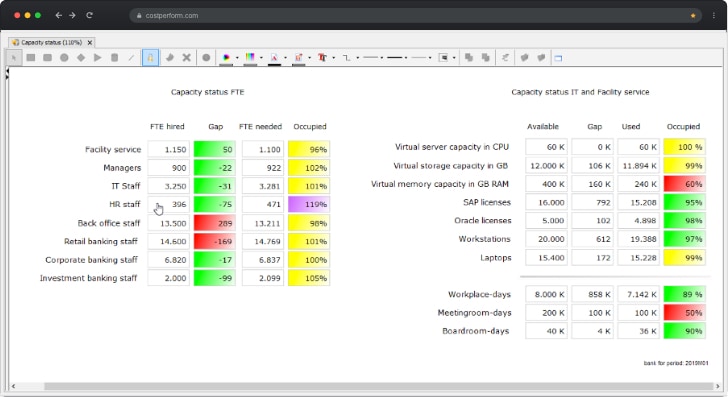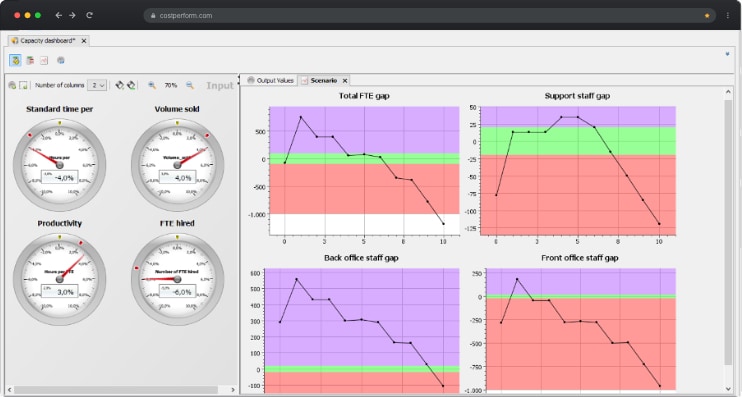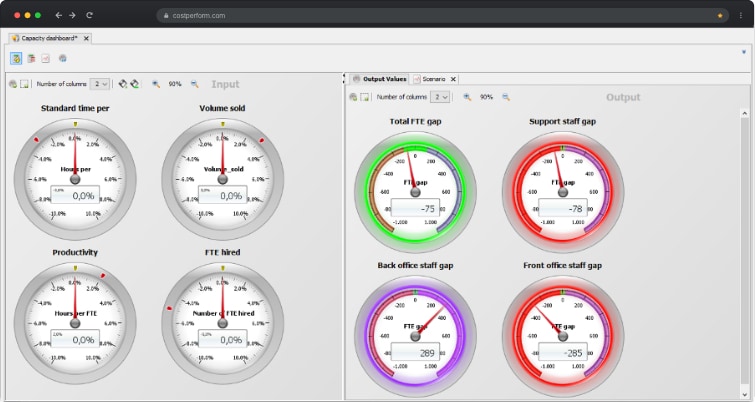Capacity Management by CostPerform
Manage your cost by managing capacity
Performing Capacity Management with CostPerform gives you exclusive insights into the way your company’s capacities are being deployed, enabling cost reductions.
What is Capacity Management?
Capacity Management is the art of managing costs and output volumes via detailed information on given and used capacities that enable the outputs in a company. If you can manage your direct and indirect labour capacity, space capacity, machine capacity, IT capacity, etcetera, you can manage your costs.
Capacity Management is still one of the core instruments to run a business. Unfortunately, many organizations have forgotten about ‘good old’ Capacity Management or believe it’s not applicable in their situation – while most of the time the opposite is true. We know from experience that Capacity Management can be applied in any situation and always has added value for businesses.
This is how Capacity Management works
Suppose you’re the manager of the CostPerform Business School and you sell courses. Traditionally, you’d ask the teaching staff on how they spend their time and which percentage goes into each course. You enter this information into CostPerform and you let the cost management software push the costs from your teaching staff to the courses. The costs of the dean, the admin, the building, etcetera, just follow the allocations of the teaching staff. From a costing point of view, an accurate estimation of the time spent gives a pretty accurate allocation of costs. But in this case, you might face three issues:
How sure are you that the percentage split is correct and/or accurate?
What happens to the percentage split in case the student- or course mix is changing over time?
Other costs might have another ‘dynamic’ than staff time. The admin costs might be driven by the number of students and courses they follow. The fixed asset costs are driven by group usage and not by individual students.
In other words, traditional models are okay to allocate costs but are most of the time not accurate enough, hard to audit and they cannot answer any what-if questions on future output changes

CostPerform is designed and built to serve any costing method, giving you numerous options to calculate cost prices as accurately as possible
A capacity-aware cost model
As a cost manager, you want to know how much of the capacity is used for productive work, meetings, etcetera, and how much capacity is wasted or can be used for more courses or research. In a capacity-aware model, the allocation of costs follows the usage of capacity. So, let’s make the model we talked about in the beginning capacity-aware by adding more details on the courses.
Suppose the course ‘CostPerform introduction’ takes 2 sessions, 4 hours each and requires 2 hours of preparation time. On top of that, each student – on average – gets half an hour of individual attention from the professor. To enrol, the school admin does some work, let’s say 15 minutes to register and invoice the student. Instead of asking staff for the time-split percentage time-split, you can predict how much staff time it takes to execute the course because the cost allocation will follow the capacity usage of the courses. So, you only ask the staff if the assumptions you made per course are still valid.
The next step is to look for more information about your staff. You know how many persons you have on the payroll and how big your staff is in terms of FTE. Since the course info allows you to calculate the number of staff hours needed, it’s logical to also know how much hours of staff capacity you have. If you assume a certain number of productive hours per FTE you can calculate your given capacity. Next, depending on the course mix, volume and course information, the needed capacity can be pulled away from the given capacity. If the courses pull too much capacity, it means you probably cannot deliver the volume or you have to hire extra capacity. If the courses do not pull all capacity, you should ask questions. What’s the staff doing more than only teaching? Or; is the productivity not too high?
Isolate the problem
Sometimes unpleasant questions can trigger resistance but they can also change the staff attitude towards their own performance. Detecting over-used capacity can be helpful for the staff to show that they have to work too many hours or to discuss if the quality or the delivery of the product can be altered so it needs less capacity.
And the costs? Is it fair to charge students for unused capacity? In capacity-aware models, every unit of capacity used is valued against the capacity rate (the total costs of the capacity divided by the assumed maximum units of capacity). When the school produces at full capacity, the products are delivered efficiently at the lowest possible costs. But what do you charge if the school has unused capacity? Just charge it to the students and outprice your products or isolate the problem and try to solve it and stay cost-leader in your market? Thanks to CostPerform’s Capacity Management solution you can easily do the latter and stay on top of your business and outperform the competition.

Most important
Capacity Management features
Enables predictive costing and running sophisticated what-if scenarios
By managing your capacity, you can manage your costs
Lets you find bottlenecks, unused and overused capacity to trigger business improvement initiatives
Lets you find bottlenecks, unused and overused capacity to trigger business improvement initiatives
This is what Capacity Management does
Capacity Management enables organizations to focus on the use of available capacities to influence costs. This is possible and relevant because costs follow the use of capacity, and the use of capacity is triggered by the output of an organization. More output means more capacity use, resulting in more costs. Capacity Management focusses on these cause-and-effect relationships, making predictive costing and running sophisticated scenario analysis possible – two great tools to get a grip on your costs and manage them in the future.
Advantages of Capacity Management
- Enables predictive costing
- Enables running what-if scenario analysis
- Enables workforce planning
- Enables zero-based budgeting
- Supports budget requests
- Supports base costing with real cause-and-effect relations
- Allows fact-based ‘cost of capacity’ allocations
No matter how complex and big your business is, CostPerform is Capacity Management.
CostPerform Capacity Management in short
Costs follow capacity, so if you manage your capacity you manage your costs. It’s a rule of thumb in business economics. Thanks to capacity-aware cost models you can use the right ‘handles’ to improve business performance and maybe gain an advantage over the competition. Why and how much capacity is wasted? What can you do to avoid unused capacity? And where’s the bottleneck capacity in the production process? Typical questions you can best answer with capacity-aware cost models – exactly what CostPerform is designed for, as well as for predictive costing and running what-if scenario analysis. And no matter how complex and big your business is, CostPerform is Capacity Management.

Request a demo
Fill in the form below and we will reach out to you to plan an online demo of our cost management software.